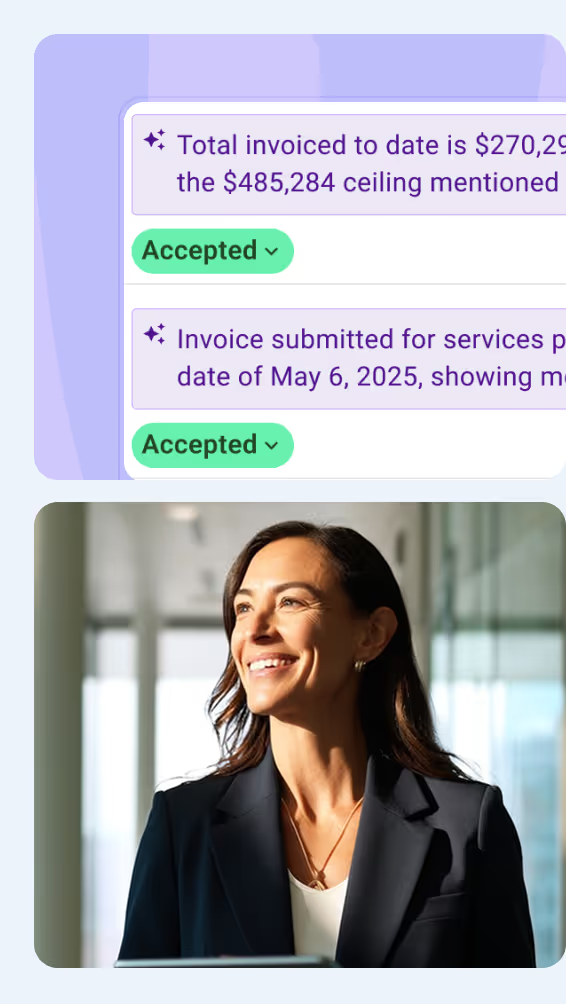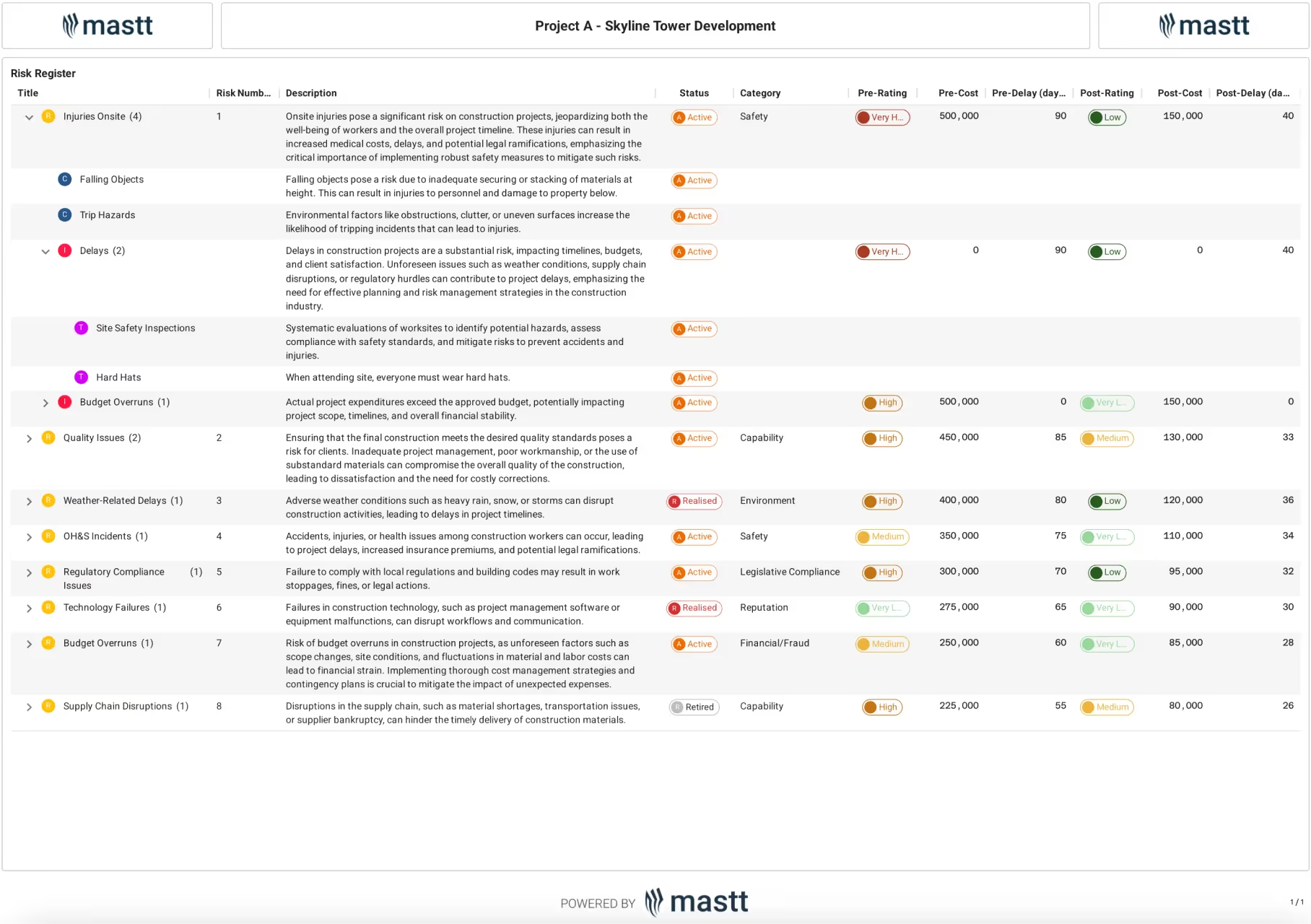Costs can rise fast in construction projects, leading to budget problems and delays. Cost risk analysis helps you spot risks early, so you can take action before they cause serious trouble.
To keep projects on track, you need to know what causes cost risks, how to calculate them, and the best ways to manage them.
With methods like contingency planning and risk-adjusted forecasting, project owners and client-side PMs can prepare for cost changes and avoid financial surprises.
What is a Cost Risk Analysis?
Cost risk analysis is the process of identifying and evaluating financial risks that could cause a project’s costs to exceed estimates. It's a project controls tool that helps project owners, client-side PMs, and capital project teams understand where uncertainties lie and take proactive steps to manage them.
At its core, ‘cost risk’ refers to the possibility of cost overruns due to unexpected factors like inaccurate estimates, material price fluctuations, scope changes, or unforeseen site conditions. These risks can delay projects, increase costs, and impact overall profitability.
What is the Primary Purpose of Cost Risk Analysis?
The primary purpose of cost risk analysis is to prevent budget overruns and improve financial planning. It helps project owners, client-side PMs, and capital project teams identify risks that could increase costs and take action before they impact the project. Without it, unexpected expenses can lead to delays, funding shortages, and financial losses.
A well-structured cost risk assessment allows teams to:
- Plan for uncertainties: Identify cost risks early and set aside contingencies.
- Keep budgets on track: Reduce unexpected expenses and prevent overspending.
- Use resources wisely: Allocate funds where they’re needed most.
- Make informed decisions: Adjust financial plans based on actual risk data.
- Ensure project stability: Avoid cost overruns that cause delays or disputes.
Financial risks are unavoidable in construction and capital projects, but they can be managed. A strong risk cost analysis ensures teams stay prepared, making projects more predictable and financially secure.
If you want to learn more, read our Project Cost Management guide for a comprehensive approach to controlling costs and reducing financial risks.
How Do You Perform and Calculate Cost Risk?
To perform and calculate cost risk, you need to determine what could make a project cost more, figure out how likely each risk is to happen, estimate how much money it could add, and adjust the budget to prepare for it.
Here’s a simple step-by-step guide to performing cost risk analysis:
Step 1: Identify Possible Cost Risks
The first step in cost risk analysis is to list everything that could make the project more expensive. These risks can come from different areas, like rising prices, project delays, or mistakes in budgeting.
Common cost risks that increase project costs include:
- Higher material and labor costs: Prices for materials or worker wages may increase due to supply shortages, inflation, or sudden demand.
- Changes to the project scope: Adding new work, redesigning, or changing materials can raise costs.
- Rules and permit requirements: New government regulations, environmental laws, or permit fees can add unexpected expenses.
- Delays in the project: Poor planning, late approvals, or contractor issues can slow things down and increase labor costs.
- Problems with suppliers: If materials arrive late or are unavailable, the team may have to buy more expensive alternatives.
- Unexpected site conditions: Hidden problems, such as weak soil, old pipes, or hazardous materials, may require extra work and money.
To ensure no risks are missed, teams should talk to project managers, cost engineers, and suppliers. Looking at past projects and checking market trends can also help.
⚡ Pro Tip: Use Mastt for real-time budget tracking, automated risk assessment, and simplified reporting to stay ahead of cost risks.
Step 2: Estimate the Likelihood and Cost of Each Risk
Not all risks will happen, and some are more expensive than others. The next step is to figure out:
- How likely each risk is to happen (probability %): Some risks are rare, while others happen often.
- How much extra money it could cost (impact $): Some risks may only add a small amount to the budget, while others could cause huge increases.
For example:
- Material cost increase: 40% chance of happening, possible extra cost of $100,000.
- Regulatory delay: 20% chance of happening, possible extra cost of $200,000.
- Labor shortage: 50% chance of happening, possible extra cost of $50,000.
These numbers can be based on past project data, expert opinions, and construction cost trends.
Step 3: Calculate Cost Risk Using a Simple Formula
To put a number on how much risk a project faces, teams can use a simple formula called Expected Monetary Value (EMV). This formula helps figure out how much money should be set aside to cover risks if they happen.
🧮 Cost Risk Analysis Formula: Cost Risk = Probability × Cost Impact
Example Calculation for Multiple Risks
Now, let’s calculate the total cost risk for a project by applying the formula to the risks we listed earlier:
- Material cost increase: 40% probability, $100,000 impact
- EMV = 0.40 × 100,000 = $40,000
- Regulatory delay: 20% probability, $200,000 impact
- EMV = 0.20 × 200,000 = $40,000
- Labor shortage: 50% probability, $50,000 impact
- EMV = 0.50 × 50,000 = $25,000
The total cost risk for this project is: 40,000 + 40,000 + 25,000 = $105,000
This means that at least $105,000 should be added to the budget to cover these risks if they happen.
Step 4: Adjust the Budget and Monitor Risks
After calculating the total cost risk, teams must update the project budget and continue tracking risks to ensure they are prepared.
To manage cost risks effectively:
- Add contingency budget: Allocate the calculated cost risk amount ($105,000 in this example) as a financial buffer. Use risk-adjusted forecasting to ensure the project budget accounts for potential overruns.
- Keep an eye on risks: Monitor market fluctuations, material prices, labor costs, and regulatory changes that could impact the project. If new risks arise or existing ones worsen, update the calculations using Monte Carlo simulation or sensitivity analysis.
- Use structured risk tracking methods: Conduct regular risk register updates and financial reviews with project teams. Tools like Earned Value Management (EVM) and Expected Monetary Value (EMV) help quantify cost risks and improve decision-making.
Take note that cost risk analysis is not something you do just once. It should be reviewed regularly to ensure that budgets stay accurate and that risks don’t turn into expensive problems.
What Causes Cost Risk in Projects?
Cost risk happens when a project ends up costing more than planned. This can happen because of mistakes in budgeting, price changes in materials, or delays on-site.
Here are the most common reasons projects go over budget:
- Wrong cost estimates: If the budget is based on rough guesses, actual costs can be much higher.
- Material and labor price changes: Market conditions, inflation, or supply shortages can drive up costs.
- Project scope changes: Adding new features or changing plans results in cost escalation.
- Regulations and permits: New rules, compliance fees, or unexpected approvals can add costs.
- Unexpected site conditions: Hidden problems like unstable ground or old utilities can require extra work.
- Delays and inefficiencies: Slow decision-making, contractor issues, or rework can lead to extra expenses.
- Supply chain problems: Late deliveries or material shortages can force teams to buy costlier alternatives.
For example, a construction project may budget for steel at a set price, but supply shortages cause prices to rise by 20%. If the project doesn’t have a backup plan or contingency funds, this extra cost could throw off the entire budget.
What is a Cost Benefit Risk Analysis?
A cost benefit risk analysis is a way to compare the costs, benefits, and risks of a project or decision. It helps teams decide if a project is worth doing by weighing what they will spend, what they will gain, and what could go wrong.
A cost benefit risk analysis answers three key questions:
- What are the costs? This includes materials, labor, equipment, permits, and other expenses.
- What are the benefits? These can be increased revenue, cost savings, efficiency improvements, or long-term financial gains.
- What are the risks? These are the uncertainties that could increase costs or reduce benefits, like supply chain delays, price changes, or legal issues.
By comparing these factors, teams can make better decisions about whether to move forward, adjust the project plan, or find ways to reduce risks.
How to Perform a Cost Benefit Risk Analysis
To complete a cost benefit risk analysis, follow these steps:
- Identify all costs: List every expense related to the project. This includes direct costs (materials, labor) and indirect costs (maintenance, insurance, or compliance fees).
- Determine the expected benefits: Identify the financial gains, such as higher profits, increased efficiency, or reduced long-term costs.
- Assess the risks: Identify what could go wrong and how much it could cost. Risks might include price increases, delays, or regulatory issues.
- Assign values to each factor: Estimate the dollar amount for each cost, benefit, and risk to get a clear financial picture.
- Compare the results: If the benefits outweigh the costs and risks, the project is financially reasonable. If not, adjustments may be needed to reduce risks or cut costs.
This process helps teams avoid projects that may become financial burdens and focus on those that offer the best value.
Example of a Cost Benefit Risk Analysis
A construction company is deciding whether to switch to a new building material that costs more but could shorten the project timeline.
Step 1: Identify the Costs
The new material costs $500,000 more than traditional materials.
Step 2: Determine the Benefits
Using the new material will reduce construction time by three months, saving $700,000 in labor and equipment costs.
Step 3: Assess the Risks
There is a 30% chance of supply chain delays, which could add $100,000 in extra costs.
Step 4: Calculate the Net Benefit
Net Benefit = Savings − Cost − Risk Cost
700,000 − 500,000 − 30,000 = 170,000
Since the net benefit is positive ($170,000), the project is financially justifiable. The company may decide to proceed but also take steps to reduce the risk of supply delays.
Use Mastt for Easier Cost Risk Analysis
Keeping projects on budget starts with the right construction cost tracking sofware. Mastt makes cost risk analysis simple by helping you track costs, assess risks, and make better financial decisions.
Here’s how Mastt helps with risk cost analysis:
- Track costs in real time and spot risks before they grow.
- Automate risk assessments to see the financial impact of each risk.
- Generate reports instantly without sorting through spreadsheets.
Mastt gives project owners and client-side PMs the clarity they need to manage costs with confidence. Stay ahead of financial risks and keep your budget under control. Try Mastt today!






.avif)








![Controls Chart in Project Management [Examples]](https://cdn.prod.website-files.com/607f739c92f9cf647516b37b/67ed9bb5c66a6a9d585a90dc_controls-chart-in-project-management.avif)
